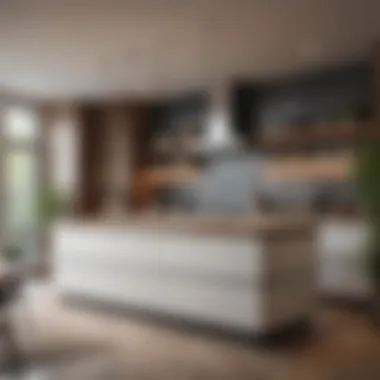Essential Steps for a Successful Kitchen Renovation


Intro
Renovating a kitchen can be a daunting but rewarding experience. Many homeowners find themselves overwhelmed by the myriad of decisions to make and the complexity of the process. Understanding how to approach this project can lead to better outcomes and an improved space. This article will guide you through the essential steps of starting a kitchen renovation. It will cover important aspects like planning, budgeting, material selection, and working with contractors. Grasping these elements will help ensure your kitchen reflects your style while meeting your everyday needs.
Interior Design Tips
A crucial part of any kitchen renovation is the design. Proper planning can lead to a more functional and aesthetically pleasing space.
Trendy Design Ideas
Exploring current trends can inspire your renovation. Open floor plans, minimalist aesthetics, and eco-friendly materials are gaining popularity. Many people now prioritize multifunctional spaces that combine cooking with socializing. Consider incorporating an island that serves as both a workspace and a gathering area.
Color Schemes and Combinations
Color plays a significant role in the kitchen's atmosphere. Neutral palettes like whites, greys, and beige create a timeless look. To add vibrancy, consider incorporating accents such as bold blues or greens through accessories or cabinetry. The key is balancing bold colors with more subdued tones to maintain harmony in the space.
Furniture Arrangement Techniques
Proper arrangement can optimize space and workflow. Lean towards the classic work triangle setup, placing the stove, sink, and refrigerator in a triangular layout. This arrangement enhances efficiency while cooking. Maximizing storage with smart cabinetry can also help reduce clutter, allowing for a more organized kitchen.
"Designing a kitchen is not just about aesthetics; it’s about creating a functional space that enhances daily life."
Budgeting for Success
A well-defined budget is vital for any renovation. Begin by determining how much you can realistically spend. Include costs for materials, labor, and unexpected expenses. It's wise to allocate 10-15% of your budget for unforeseen costs. This way, you won't be caught off guard later in the process.
Selecting Materials
The choice of materials significantly impacts durability and aesthetics. Research different options for countertops, cabinets, and flooring. For countertops, granite and quartz are popular for their longevity and style. When selecting cabinets, consider solid wood for a more upscale appearance, though there are good quality alternatives too.
Managing Timelines
A kitchen renovation requires careful planning of timelines. Start by outlining your project's phases, including demolition, construction, and installation. Keep in open communication with your contractor about timelines to minimize delays. This clarity will help manage expectations and reduce frustration.
Contractor Selection
Choosing the right contractor can influence the success of your renovation. Seek recommendations and review portfolios to find professionals who align with your vision. Ensure they are licensed and insured for peace of mind. Also, gather multiple quotes to compare pricing, but remember that the lowest bid may not always deliver the best quality.
Epilogue
Starting a kitchen renovation involves several key steps, from designing your ideal space to managing your budget and finding the right materials and professionals. By understanding these processes, you can approach your project with confidence. Remember that planning thoroughly will lead to a successful kitchen that meets your aesthetic preferences and functional needs.
Understanding the Basics of Kitchen Renovation
Understanding the basics of kitchen renovation is crucial for homeowners considering a transformative project. This phase sets the groundwork, influencing the entire renovation journey. Emphasizing clear objectives and outlining current kitchen issues will guide decision-making processes. Knowing what to expect while renovating ensures that choices align with both functionality and aesthetic preferences.
Defining Your Renovation Goals
Defining renovation goals requires introspection about your kitchen's purpose and how it fits into your lifestyle. Start by pondering the following questions:
- What activities take place in your kitchen: cooking, entertaining, or family gatherings?
- Are you looking for improved functionality or simply a fresh aesthetic?
- Do you have specific styles or themes in mind?
Clearly stating your objectives will provide direction throughout the renovation. For instance, a homeowner focused on hosting may prioritize open layouts and seating arrangements, while a passionate cook might focus on storage and countertop space. Write down these goals for reference as you move forward.
Identifying Your Kitchen's Current Issues


Every renovation begins with an assessment of the existing space. Identifying the current issues is a vital step.
- Layout Efficiency: Are the work zones, such as prep, cooking, and cleaning, easily accessible?
- Storage Solutions: Is there adequate storage or are items often cluttered?
- Outdated Fixtures: Check appliances, cabinets, and countertops for wear and tear.
- Aesthetics: Does the current design feel outdated or poorly reflective of your style?
Taking the time to observe these issues can clarify what needs fixing and can influence the design choices you will make later. Prioritizing these aspects can result in a more effective and pleasing renovation.
Budgeting for Your Kitchen Renovation
Budgeting for your kitchen renovation is a crucial step that significantly influences the project's overall success. A well-structured budget provides a clear financial framework for your renovation, allowing you to make informed decisions throughout the process. Understanding the costs involved will ultimately help you achieve your desired kitchen without overspending or facing financial strain.
Establishing a Realistic Budget
Creating a realistic budget begins with assessing your financial situation. Here are some key considerations:
- Evaluate Your Finances: Begin by reviewing your current savings and available credit. Determine the amount you can comfortably allocate to the renovation.
- Research Typical Costs: Investigate the average costs of kitchen renovations in your area. Online resources, such as cost estimators, can provide valuable insights.
- Create a List of Needs vs. Wants: Clearly differentiate between essential upgrades and those that are purely aesthetic. Prioritize based on importance, which can help maximize your budget.
- Seek Professional Advice: Sometimes, consulting a financial advisor or contractor can uncover costs you might not have considered.
By systematically evaluating your finances and prioritizing your needs, you can set a budget that supports your vision.
Incorporating Contingency Funds
In any renovation, unexpected expenses often arise, making contingency funds essential. Here's how to effectively incorporate them into your budget:
- Set Aside 10-20% of Your Total Budget: This percentage serves as a buffer against unforeseen costs like damage or changes in materials.
- Be Specific about Potential Risks: Consider areas of your kitchen that are older or require significant changes. For example, plumbing issues can arise unexpectedly during remodeling.
- Use Contingency Wisely: Only touch this fund when absolutely necessary. This practice ensures that your primary renovation budget stays intact.
Having this cushion allows you to navigate the renovation with less stress.
Understanding Cost Breakdown
Understanding what constitutes your costs can help you manage your budget more effectively. Here are the main components:
- Design Fees: If you're hiring a designer, factor in their fees. It can be a flat rate or an hourly charge depending on your needs.
- Materials: This includes countertops, cabinets, flooring, and fixtures. Researching various options will help you find a balance between quality and cost.
- Labor: Skilled professionals like electricians and plumbers may charge a premium. Get multiple quotes to find suitable prices.
- Permits and Inspections: Don’t forget to include costs for necessary permits, as these can vary by location.
A detailed cost breakdown not only reveals where your money goes but also identifies areas for potential savings.
Investing in proper budgeting lays the groundwork for a smoother renovation experience, ensuring you can achieve your dream kitchen without unnecessary stress.
Design Planning and Layout Considerations
Design planning and layout are fundamental steps in any kitchen renovation. They significantly influence not only the aesthetics of your kitchen but also its functionality. A well-thought-out design ensures that your space meets your cooking and socializing needs, while an effective layout maximizes available square footage.
Choosing an Effective Kitchen Layout
When considering your kitchen layout, the main goal is to create a flow that will make cooking and social interactions more efficient. There are several popular layouts, such as the U-shaped, L-shaped, and galley designs. Each layout has specific benefits depending on your kitchen's size and shape. The U-shaped layout offers ample counter space and storage, making it ideal for larger kitchens. The L-shaped layout is great for saving space and promoting easy movement between work zones. Galley kitchens, while compact, can be highly functional if designed thoughtfully.
Keep in mind the kitchen work triangle, which refers to the optimal distance between the stove, sink, and refrigerator. This triangle should be efficient and comfortable to navigate. A clear understanding of your cooking habits can guide your layout choice, ensuring it aligns directly with your needs and lifestyle.
Selecting Materials and Finishes
Choosing the right materials and finishes is vital for both functionality and aesthetics. Durable materials will sustain daily use while enhancing your kitchen's appeal. For countertops, consider options like granite or quartz, which offer longevity and require minimal maintenance. Cabinets can be made from solid wood for a timeless look or laminates for budget-friendly alternatives.
Flooring choices should also reflect practicality. Porcelain tile is resilient and easy to clean, while hardwood provides warmth but may need more maintenance. Your finishes, including colors and textures, should resonate with your established design theme. Think about how the materials can complement each other and contribute to a cohesive aesthetic throughout the space.
Incorporating Storage Solutions
Maximizing storage in a renovated kitchen is essential. A well-organized kitchen reduces clutter and improves functionality. Look for creative storage solutions, such as pull-out shelves, lazy Susans, and deep drawers for pots and pans. These features not only enhance accessibility but also utilize space efficiently.
Consider vertical storage options like shelves above countertops or cabinets that reach the ceiling. This clever use of space can provide additional storage without sacrificing floor area. Incorporating hidden storage, like toe-kick drawers or pantry pull-outs, can further enhance your kitchen's efficiency.


"The design of your kitchen reflects your personal style and impacts the ease of daily tasks. Planning ahead is not just prudent; it’s essential."
In summary, thoughtful design planning and layout considerations directly affect the success of your kitchen renovation. By choosing an effective layout, selecting durable materials, and optimizing storage, you can create a kitchen that is not only functional but also visually appealing.
Sourcing and Selecting Contractors
Selecting the right contractors is a crucial step in the kitchen renovation process. The outcome of your project heavily depends on the professionals you choose. Skilled contractors can bring your vision to life, ensuring both quality craftsmanship and adherence to timelines. To minimize stress during your renovation, it is essential to undertake thorough research, conduct interviews, and verify credentials before making a final decision.
Researching Contractors and Professionals
Researching contractors begins with compiling a list of potential candidates. Start by tapping into local resources such as word of mouth, online directories, and community boards. Websites like Yelp or Angie’s List provide user reviews that offer insights into a contractor's reliability and quality of work. You can also check platforms like Facebook or Reddit for community recommendations.
When researching, consider the following:
- Specialization. Some contractors focus on specific types of renovations. Verify that they have experience in kitchen transformations, as this involves unique skill sets.
- Portfolio. Examine past projects to determine if their style matches your needs. A professional should have an accessible portfolio showcasing completed work.
- Licensing. Ensure that your contractor holds valid licenses and insurance. This provides protection for both you and the contractor, safeguarding against potential legal issues later on.
Interviewing and Requesting Quotes
Once you have narrowed down your list, the next step is to interview each candidate. Prepare a set of specific questions aimed at assessing their experience, approach to kitchen renovation, and project management skills. Some key questions to consider include:
- What is your estimated timeline for this project?
- Can you provide references from previous clients?
- How do you handle unexpected challenges during renovation?
Requesting detailed quotes is equally important. Each contractor may provide different pricing structures, so asking for itemized quotes helps in understanding what is included. Look out for hidden costs, which can significantly affect your budget. Get at least three quotes to compare and make an informed decision.
Verifying Credentials and References
Before hiring a contractor, verification is paramount. Contact references provided during the interview process. Ask previous clients about their experience, adherence to deadlines, and overall satisfaction with the work performed.
Additionally, check for any complaints registered with the Better Business Bureau or similar organizations. This allows you to gain a better perspective on a contractor's reputation.
Check their online presence. Websites like En.wikipedia.org or Britannica.com can provide credible information about practices and standards in renovation that align with your expectations.
"The selection of your contractor can make or break your kitchen renovation journey. Take the time to choose wisely."
Summarize your findings and eliminate contractors who do not meet your standards. Once you feel confident in your choice, you can proceed to finalize contracts and begin the renovation process. A well-chosen contractor can transform your kitchen while minimizing stress, ensuring you achieve a beautiful and functional space.
Timelines and Project Management
Timelines and project management are critical components of any kitchen renovation. Establishing a clear timeline not only helps in organizing tasks but also sets expectations for the project’s duration. Homeowners can avoid unnecessary stress by planning out when various phases will occur. Understanding how to manage a project effectively can lead to a smoother renovation experience.
Creating a Renovation Timeline
Creating a renovation timeline involves outlining the entire scope of the project. Start by determining your overall goals. Break down each phase—from planning, demolition, construction, to final inspections. It is helpful to use a project management tool or a simple spreadsheet to track progress.
- Outline Major Phases: Identify major milestones, such as the completion of design plans, the start of demolition, and the installation of major appliances.
- Set Specific Dates: Assign target dates for each milestone. This promotes accountability and planning.
- Consider Subcontractor Schedules: If you are hiring, coordinate with contractors to fit their workflows into your timeline. This helps to avoid overlaps and ensures timely completion.
Managing Workflow and Scheduling
Managing workflow during a kitchen renovation ensures that work proceeds efficiently. This involves coordinating various contractors and tasks.
- Daily and Weekly Planning: Set up a daily and weekly schedule to review tasks. Make sure that each party involved understands their responsibilities on specific days.
- Utilize Communication Tools: Employ tools like Slack or Trello to keep the lines of communication open. Regular updates decrease misunderstandings and provide clarity.
- Prioritize Key Tasks: Identify crucial tasks that must be completed before others can begin. For example, heaving demolition needs to occur prior to fitting cabinets.
Dealing with Delays and Changes
Delays are often inevitable in renovation projects. Being prepared to adapt is key to overcoming challenges.
- Build Flexibility Into Your Timeline: When creating your timeline, add extra time between phases to account for potential delays. This reduces frustration when issues arise.
- Communicate with Contractors: If changes to timelines occur, contact contractors immediately. Keeping everyone informed minimizes disruption.
- Have Backup Plans: Always have contingency strategies in case a specific task is delayed, such as sourcing alternative materials or adjusting your project scope.


"Planning is everything. The more you prepare, the less stressful your renovation will be."
In summary, emphasizing timelines and project management in your kitchen renovation can lead to a successful outcome. Being organized helps manage expectations and navigate any unforeseen challenges effectively.
Design Aesthetics and Personalization
Renovating a kitchen offers more than just an opportunity for functional improvement. It allows homeowners to create a space that resonates with their personal taste and style. Design aesthetics and personalization are crucial elements that shape the environment where meals are prepared, families gather, and memories are made. Taking time to consider these aspects can enhance not only the appeal of the kitchen but also its overall usability. This section will delve into the specific elements that contribute to aesthetic design, the importance of establishing a cohesive theme, and how personal touches can make the space uniquely yours.
Establishing a Design Theme
A clear design theme serves as a guiding principle throughout the renovation process. It determines the feel of the kitchen and influences decisions surrounding materials, layout, and décor. Here are some essential considerations when establishing a design theme:
- Functionality: The theme should align with how you use your kitchen. For instance, a modern minimalist approach may emphasize open spaces and uncluttered surfaces, suitable for those who prefer simplicity.
- Cohesion: Ensure your design theme is consistent with the rest of your home. This creates a harmonious transition between spaces.
- Inspiration: Look for inspiration in magazines, online platforms like Pinterest, or even travel experiences. Collect images that resonate with you to develop an idea of your desired theme.
Choosing Color Schemes and Patterns
The right color scheme can significantly influence the atmosphere of a kitchen. Colors evoke emotions and can create either a calming or energetic ambiance. Here are points to consider:
- Neutral vs. Bold: Neutral colors can offer a classic and timeless look. In contrast, bold colors can energize the space. Choose a palette that fits your lifestyle and aesthetic preference.
- Complementary Colors: Often, combining complementary colors can add depth to the space. For example, pairing warm wood tones with cool blues can create an inviting environment.
- Patterns: Carefully selected patterns can serve as focal points. Consider using patterned backsplashes or textiles that enhance your chosen color scheme without overwhelming the space.
Incorporating Personal Touches
Personal touches are what ultimately transform a kitchen from a mere cooking area to a truly special space. These elements reflect individuality and can make the kitchen feel more inviting. Here are some ways to personalize your kitchen:
- Art and Décor: Hang artwork or display unique decorative items that resonate with your interests or experiences.
- Functional Accessories: Use kitchen tools or utensils that are not only functional but also visually appealing. Attractive containers for spices or custom cutting boards can enhance the space.
- Photographs and Memorabilia: Incorporate personal photographs or items collected from travels. These elements tell your story and invite conversation.
The kitchen is the heart of the home. Personalization elevates it from a standard design to an expression of life, culture, and family.
Through intentional design aesthetics, cohesive themes, thoughtful color selections, and cherished personal touches, homeowners can craft a kitchen that meets their practical needs while embodying their unique identity. Engaging in this reflective process ensures that the renovation is not just about updating a space but also about creating a hub of creativity and comfort.
Post-Renovation Considerations
After the dust settles from your kitchen renovation, it is crucial to consider several aspects to ensure everything remains in top condition and operates as intended. Post-renovation considerations are not merely a final check; they are the bridge between the conceptual design and day-to-day functionality of your kitchen. Emphasizing this phase can significantly enhance your space's aesthetic and practical value.
Final Inspections and Adjustments
Once the renovations are complete, conduct thorough inspections of all installed elements. Check cabinets, countertops, and appliances for any issues. Pay close attention to functionality; cabinets should open smoothly, and appliances should operate without a hitch.
Make a list of any adjustments needed. For example, if a cabinet door does not close properly, it's worth addressing immediately rather than letting it continue.
After initial checks, consider scheduling a follow-up inspection with your contractor. They can provide insights into any corrections required, ensuring that the work meets the expected standards. This step is vital for confirming that the project reaches its full potential before you move into your newly renovated kitchen.
Maintaining Your Renovated Kitchen
Regular maintenance is key to prolonging the life of your renovated kitchen. Establish a cleaning schedule to keep surfaces, appliances, and fixtures in good condition. Use suitable cleaning solutions for different materials to avoid damage.
- Countertops and Surfaces: Clean with mild dish soap and water. Avoid abrasive cleaners as they can scratch or damage the finish.
- Appliances: Regularly check and clean refrigerator coils, and use specialized cleaners for ovens and microwaves.
- Cabinetry: Wipe down cabinets with a damp cloth and apply polish when necessary to protect the finish.
Incorporating maintenance into your routine prevents more extensive repairs down the road. This habit can also help retain the kitchen's appearance, ensuring it remains a point of pride in your home.
Evaluating the Success of Your Renovation
To assess the success of your kitchen renovation, reflect on the objectives set at the beginning of the project. Ask yourself: Did the renovation meet your goals? Are the kitchen's aesthetics and functionality aligned with your vision?
Gather feedback from family and friends who use the kitchen regularly. Their input can offer valuable perspectives you might overlook. Moreover, monitoring how well the kitchen serves your needs over time can reveal areas for improvement or further adjustments.
Creating a checklist of key outcomes will help facilitate this evaluation.
- Functionality: Is the workflow smooth?
- Aesthetics: Are you happy with the overall look?
- Comfort: Does the space feel inviting and usable?
Evaluating your renovation is not just about immediate satisfaction but understanding its long-term impact on your home.
By being vigilant about these post-renovation aspects, homeowners can enjoy their kitchen renovations to the fullest and ensure they lead to lasting satisfaction.







